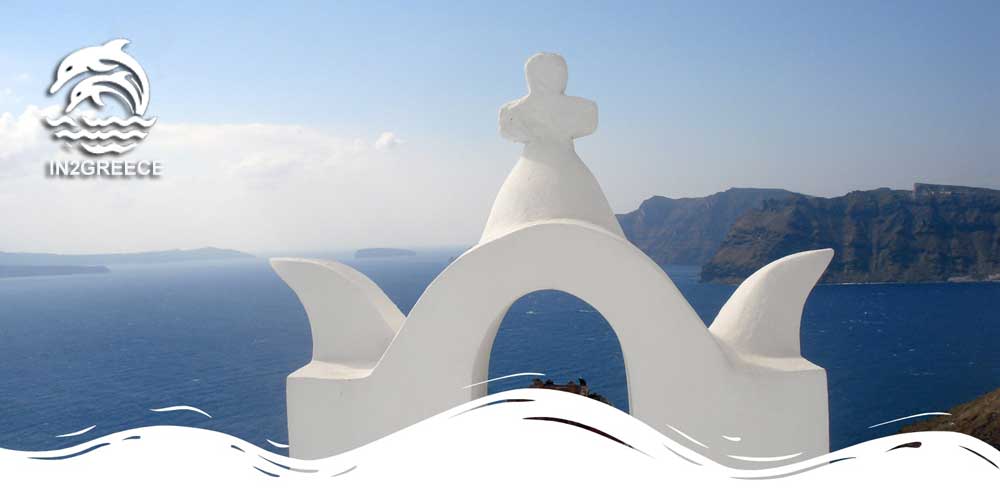Information about Poros island Greece
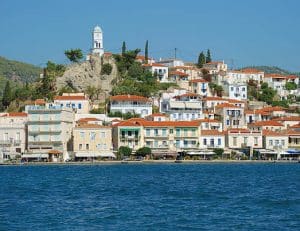
Its proximity to mainland Greece makes it a favourite weekend getaway for Athenians as well as a longer-term holiday destination for north Europeans.
Poros offers several good beaches, pine-clad countryside, some excellent traditional tavernas and a lively nightlife in high season.
The strip of water separating the two is only 360 metres at its narrowest point. Car ferries and water taxis run frequently between the island and Galatas in high season but most visitors arrive by ferry or hydrofoil from Piraeus or one of the neighbouring islands.
In the summer months there are at least eight ferries a day from Piraeus which is two and a half hours away but you can cut your journey time down to an hour by taking a highspeed hydrofoil .
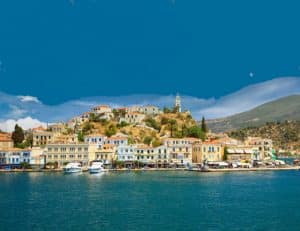
Weekenders, island-hoppers and backpackers stay in and around Poros Town whereas the apartment blocks and hotels which dominate the most popular beaches of Kalavria tend to be block-booked by the tour operators in the summer months.
Some sun, sea and sand holidaymakers never venture beyond their hotel complexes but Poros offers other attractions including the 18th century Monastery of Zoodhohou Pigis, the 6th century BC Temple of Poseidon.
The picturesque main harbour of Poros where you can relax over a leisurely meal at one of the many waterfront tavernas or take a fishing trip with one of the local boatmen. Nature lovers and hikers can enjoy some lovely walks through pine forests and olive groves to small, deserted beaches.
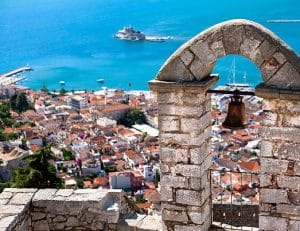
There’s the famous Lemon Forest (Lemonodassos) with its 30,000 lemon trees about three kilometres south east of Galatas near the beach at Aliki.
Elegant Nafplio, which was the first capital of Greece after independence from the Turks, is well worth a day trip with its imposing Venetian mansions and impressive Palamidi Fortress.
Epidaurus, 30 kilometres east of Nafplio, is one of the most important ancient sites in the whole of Greece with its 3 rd century BC theatre which still pulls the crowds during the annual Hellenic Festival in July and August
Poros History
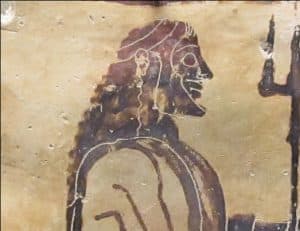
Poros had a peak period in the 6th-5th century BC especially when the temple of Poseidon became the main place of worship during the times of the Kalavrian union, a league between Athens, Nafplion, Aegina and other city states of that era.
Because of its closeness to the mainland, Poros had commercial and political connections with both Athens and the Peloponnese. Demosthenes, the orator, took his life here according to tradition.
The island had many foreign rulers, just like the rest of Greece, through history. Because of Hydras power in the 18th century, Poros was quite outshone, but the island contributed to the war of Independence that started in 1821. In Poros where confirmed the first borders of Greece in a meeting between the fist Greek Governer Kapodistrias and the ambassadors of Great Britain, France and Russia in 1828. The fist naval base and shipyards of Greece after Greek Independence was founded in Poros as well as the first school of Naval cadets. The famous battle ship Averof was docked in Poros until recent years, now the ship is docked in Faliro.



What to do in Poros
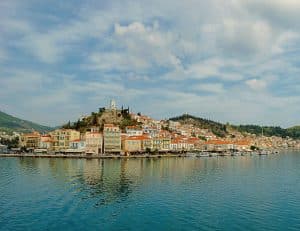
The tiny Chora, port and capital of the island, retains its ancient charm. The simple neoclassical buildings, the narrow streets that lead to the interior of the settlement and, above all, the beauty of the landscape (reminiscent of a peaceful lagoon) will make you feel like you are returning to a favorite vacation spot.
It is worth walking through the old neighborhoods, in the “Old Country” as the locals call them. Particularly picturesque is the small square next to the church of Agios Georgios and the old aqueduct.
A must is also the visit to the Clock, a trademark of the maritime state since 1927. Built on the highest peak of the hill, it has a panoramic view of the entire channel that separates the island from the opposite coast of the Peloponnese.
The visit to Poros is traditionally combined with excursions to the opposite coast of the Peloponnese with the famous Lemon Forest and the Archaeological Site of Troizina.
Days trips
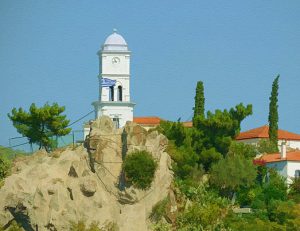
But if you take the time to explore the island and the nearby Peloponnesian area of the Greek mainland you’ll find some fascinating historic sites and places of interest to visit.
The main town and harbour of Poros, draped across three sides of the tiny volcanic island of Sferia, is well worth a few hours of exploration.
It’s a picturesque place of narrow streets and 19th century houses with a working fishing harbour where you can buy fresh fish straight from the small boats as they arrive or negotiate a fishing trip of your own with the local boatmen.
The harbourfront is lined with bars and tavernas where you can savour delicious seafood specialties and tasty traditional fare.
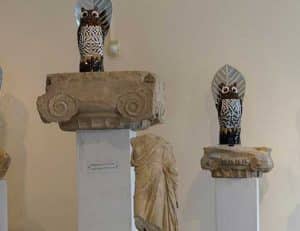
Few exhibits are from Poros – most of the finds are from Troizen, eight kilometres inland from the mainland port of Galatas, and other archaeological sites.
Six kilometres east of the town there’s the attractive 18th century Monastery of Zoodohou Pigis, built around the island’s spring (its name means Virgin of the Life-Giving Spring). Monks have been drinking the holy waters here since 200 BC but now there’s only a caretaker who may be gracious enough to show you inside where you can see a splendid gilded iconostasis (the screen separating the altar from the main part of the church). You can fill up your water bottle with the life-giving water from a fountain near the monastery.
Follow the road north of the monastery to the centre of Kalavria where you’ll find the hilltop ruins of the 6th century BC Temple of Poseidon, the god of the sea who was the favourite deity worshipped on Poros in ancient times. You won’t be able to make much sense of the ruins but the views of the Saronic Gulf and the Peloponnese are spectacular.
If you’ve “done” the island’s beaches, main town and historic sites take a trip over to the Peloponnese which is only a five-minute boat hop from Sferia.
Visit the celebrated Lemonodassos lemon grove, four kilometres south east of Galatas, where more than 30,000 lemon trees scent the air each spring. The ruins of a temple to Asclepius, the god of healing, at ancient Troizen make another popular day excursion.
Elegant Nafplio, which was the first capital of Greece after independence from the Turks, is well worth a visit with its imposing Venetian mansions and impressive Palamidi Fortress.
It’s one of the loveliest towns in the whole of Greece – mercifully free of package holiday hordes despite the wonderful sandy beach of Karathona, on the outskirts of town.
Epidaurus, 30 kilometres east of Nafplio, is one of the most important ancient sites in the whole of Greece with its 3 rd century BC theatre which still pulls the crowds during the annual Hellenic Festival in July and August.
Nightlife and entertainment
There is enough entertainment and nightlife on Poros. There are many bars and discos along the beach in Poros town, and it can get quite hectic, especially in August and during weekends, when the Athenians come over.
You’ll find many taverns in Poros town. There is a choice between Greek and international food, a special kind of lemon juice and local sweets.
In the restaurant Rota right on the promenade you can enjoy Greek specialities in reasonable prices. There are also nice small taverns in the pedestrian street paralel to the beach front.
Beaches of Poros
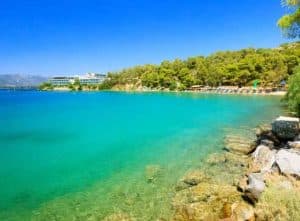
There you will also find several taverns. The same road ends, after a few kilometers, at the monastery of Zoodochos Pigi, in a location overgrown with pines and plane trees.
Just below the monastery there is a beautiful creek. Summer is a waste, but if you visit in autumn you will enjoy a wonderful swim. On the other side of the island, also a short distance from Chora, is Neorio with the organized beach with water sports.
Next to it is one of the most beautiful sandy coves of Poros, Limanaki tis Agapi. After Neorio you will come across the beach of the Russian Navy. The scenery is completed by the tiny islet of Daskalios, which seems to guard the opening of the bay.
It is definitely a special location, but it has a small drawback: its bottom is slightly muddy, as it is located on the more closed side of the “lagoon”. Less known and more difficult to reach is the pebble beach of Vagionia in the North of the island.
How to get to Poros
By ferry
The fastest way to travel to Poros, is by boat from Piraeus. There are fast ferry routes that only carry passengers and the journey takes about 1 hour. There are also conventional ferries for those who want to transport their vehicle. The duration of the trip is approximately 2 hours and 30 minutes.
By car
You can also go to Poros by car but is a long way because you have to go to Peloponesse and then to Galatas opossite Poros and from there you board the ferry boat for a short 10′ journey where you won’t even have to get out of your car.
There are daily and frequent routes from Galatas with ferry so you will not need to make a reservation in advance. From Athens you will take Olympia road and take exit EO10 towards Epidaurus/Corinth. From there you follow the signs for Methana-Galatas. The journey takes about 2 hours.
In case you don’t want to have a car in Poros, you can park it in the outdoor parking lot and take the ferry boat or a water taxi. If you want to swim, however, then it’s a good idea to cross the street with your vehicle to be able to reach the beaches of the island.
